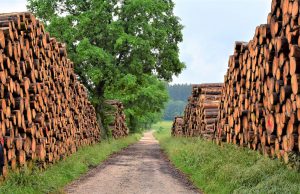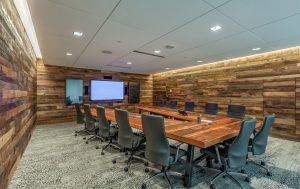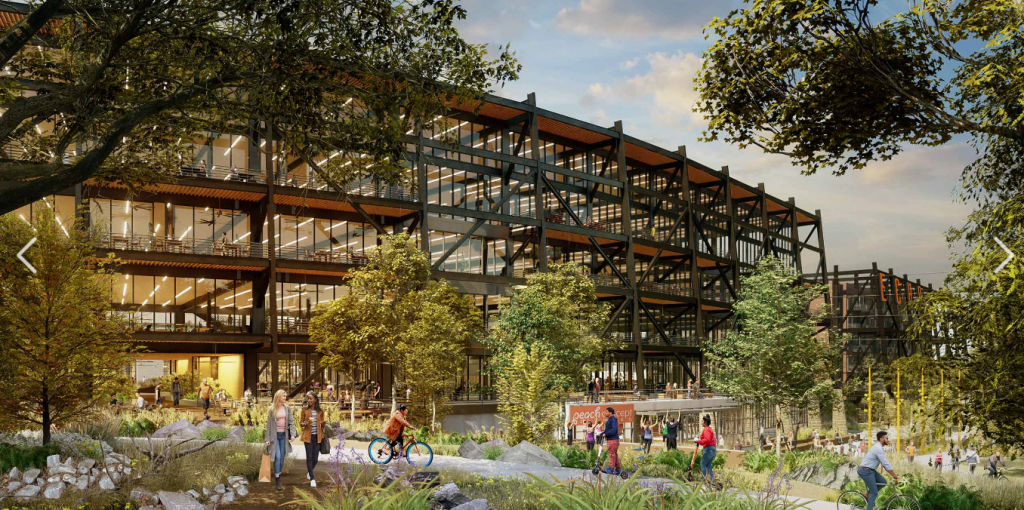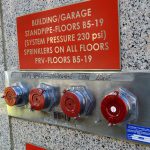How Can Timber Benefit Office Construction?
Early settlers built log cabins as early as the 17th century. Wood continued to be a major construction material until concrete and steel became the preferred choice for cities who were building higher and higher. Now, today’s leaders are rediscovering how timber can benefit office construction.
How is timber used in construction?
Wood is one of the most sustainable construction materials available today. Refining any raw material takes energy, but refining raw lumber into manufactured wood products that can be used in construction takes relatively little energy when compared to refining steel or concrete. Trees also remove carbon dioxide from the atmosphere and store it, even after it’s manufactured into wood. This means that as long as the wood can be recycled and reused, it will continue to keep this carbon from returning to the atmosphere.

“There are many additional considerations a design team must keep in mind when working with a timber structure,” Brian Hadfield, P.E., F.P.E., LEED AP, WELL AP explains. “The building façade is designed to showcase the timber inside, which means it may use a combination of more vision glass and/or taller vision glass. More glass usually means more sunlight shining in, so the mechanical systems need to be designed to accommodate the extra heat to keep occupants comfortable no matter the climate outside.”
Once inside the building, the goal of the architecture is to maximize the visibility of the timber, so the systems needed to power, cool, sprinkler, and provide IT connectivity must be accommodating. “HVAC systems can be designed to centralize equipment in mechanical rooms and only have round spiral ductwork in the tenant space,” Hadfield continues. “For a fully-coordinated tenant space, we recommend the architectural ceiling plan include all the mechanical, electrical, and plumbing elements that will be exposed as part of the overall aesthetic.”
Energy Efficiency
One way timber can benefit office construction is through energy efficiency. Wood structures are more energy efficient than steel and concrete buildings. They are lighter and require less energy to regulate them because wood breathes, unlike steel or concrete. This breathing effect has an added benefit for allergy sufferers because the wood better controls humidity that encourages the growth of bacteria.
Mental Health
Even people’s mental health can benefit from a wooden structure. Biophilia, or the idea that human beings are naturally drawn to nature, is also reinforced by timber structures. Most timber buildings leave the wood structure exposed, and even highlight it through the use of architectural lighting and/or interior design. Those living and working in the buildings can experience positive benefits such as reduced stress and increased productivity.
What happens to a timber structure during a fire?
People often think of timber as being very flammable, but in reality, natural products like wood actually burn at a slower rate than the synthetic products used in most of today’s buildings. In the case of timber buildings, wood beams of a certain thickness have an added layer of protection through charring. The wood continues to burn until a certain amount of it becomes charred, which then creates a barrier that protects the rest of the beam’s core, keeping the building structurally sound.

What about deforestation?
Deforestation is a serious problem around the world, especially because of trees’ role in balancing the atmosphere and local ecosystems. If people reintroduce wood into construction on a wider scale, you would think that forests would suffer. However, wood can be sourced sustainably by using new forests, rather than old, and harvesting timber for trees that were killed by insects or disease.
Other Challenges
Timber buildings also bring new challenges for modern technology. Design consideration for cable routes is critical because of the large timber and mostly open structure. As a solution, Alvine has been designing a cable tray pathway around the tenant floor cores to allow for neat and clean installation of cabling from the riser rooms to the tenant telecommunications rooms in recent timber projects.
The larger timbers and open structure also require more coordination with the design team, especially when it comes to wireless access point placement. Each wireless access point needs to be placed to provide the most optimal coverage for the space. By working together, the team can find a way to make each location work without taking away from the natural aesthetic.
What is T3?
T3 – or Timber, Transit, and Technology – is a timber structure model that has been embraced by Hines Interests, an international real estate firm. It provides an environment where talented professionals pursued by technology-centric companies will want to work based on access to transit, technology-rich systems, and open floor plans that promote collaboration. One example is the T3 RiNo project in Denver’s vibrant creative center, the River North Art District.
Transit/Talent
T3 buildings are located in popular downtown neighborhoods or other bustling city centers where people have many options to get around – including public transportation, biking, and walking. Public transportation reduces the carbon footprint of those living and working in the area, while biking and walking promote physical fitness. Many office and mixed-use T3 buildings also support the live, work, play model. Because travel is so convenient, people are more likely to take advantage of the dining and entertainment opportunities around them. This leads to thriving local economies and communities that attract more companies and better talent.

Technology
Today, all buildings incorporate technology integration, but T3 buildings go above and beyond. Many T3 buildings are designed to WiredScore standards, which ensure that they have the best internet connectivity available. Internet connectivity not only considers keeping tenants connected to the internet within the building, but bringing internet into the building from the outside by supporting redundancy.
Are there other examples?
T3 buildings are not the only timber structures popping up. Developers around the United States are getting creative and trying out different timber models for creative office space. Another example that Alvine and Alvine have worked on is Echo Street.

Echo Street also features timber, using a combination of cross-laminated timber, steel beams, and glass for the structure. Similar to the T3 model, Echo Street is located in a bustling city center with bike trails and other convenient transportation and entertainment opportunities, inviting top talent. Forwarding thinking, integrated technology is also incorporated to set up businesses for maximum success. The glass windows allow for plenty of natural light, which combined with clean building technology, improves the health and wellness for those that live and work in the building.
The Timber Market
Since the success of the original T3 building, similar timber projects are in various stages of design and construction all across the country. Interested in how timber can benefit your next office construction? Contact Alvine for guidance on how engineering plays a vital role in timber structures or Alvine for an interactive planning session to incorporate WiredScore design into your next project.
Want a little more information before starting a conversation?
Find out more about the physical and mental health benefits of using wood in design in “What is the WELL Building Standard?”
Questions about WiredScore? Read “What is WiredScore?” on ipdesigngroup.com/news for a simple breakdown.




